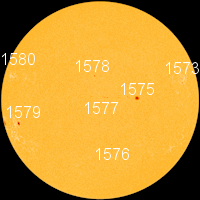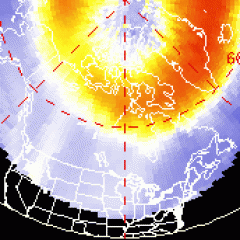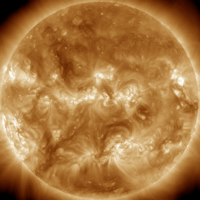~ Space Weather Update~ EMERGING BLAST SITE: [1]
MAGNETIC QUIET: The solar wind blowing around Earth is thin and steady, which means it is doing little to rattle our planet's magnetic field. Geomagnetic storms [2] are unlikely during the next 24 hours.
EMERGING BLAST SITE: A farside sunspot that exploded and hurled a bright CME [3] into space on Sept. 23rd is now rotating onto the Earthside of the sun. NASA's Solar Dynamics Observatory photographed the emerging blast site during the early hours of Sept. 26th:
Because the sunspot is still near the sun's eastern horizon, foreshortening prevents a clear view of its core magnetic structure. The events of Sept. 23rd, however, suggest that this could be a potent active region. Stay tuned for updates as the sunspot turns toward Earth. Solar flare alerts: text [5], voice [6].

![]()
Solar wind
speed: 405.7 km/sec
density: 1.4 protons/cm3
explanation [7] | more data [8]
Updated: Today at 1456 UT
![]()
X-ray Solar Flares
6-hr max: C1 1241 UT Sep26
24-hr: C1 1241 UT Sep26
explanation [9] | more data [10]
Updated: Today at: 1359 UT
![]()
![]()
![]()
Daily Sun: 26 Sep 12
![]()
![]()
Sunspot 1575 poses a slight threat for M-class [11] solar flares. Credit: SDO/HMI
![]()
![]()
![]()
Sunspot number: 121
What is the sunspot number? [12]
Updated 26 Sep 2012
Spotless Days
Current Stretch: 0 days
2012 total: 0 days (0%)
2011 total: 2 days (<1%)
2010 total: 51 days (14%)
2009 total: 260 days (71%)
Since 2004: 821 days
Typical Solar Min: 486 days
Update 26 Sep 2012
The Radio Sun
10.7 cm flux: 140 sfu
explanation [13] | more data [14]
Updated 26 Sep 2012
![]()
![]()
![]()
Current Auroral Oval:
![]()
Switch to: Europe, USA, New Zealand, Antarctica
Credit: NOAA/POES
![]()
![]()
![]()
Planetary K-index
Now: Kp= 1 quiet
24-hr max: Kp= 1 quiet
explanation [16] | more data [17]
![]()
Interplanetary Mag. Field
Btotal: 9.6 nT
Bz: 2.9 nT north
explanation [18] | more data [19]
Updated: Today at 1457 UT
![]()
![]()
![]()
Coronal Holes: 26 Sep 12
![]()
![]()
There are no large coronal holes on the Earth side of the sun. Credit: SDO/AIA.



